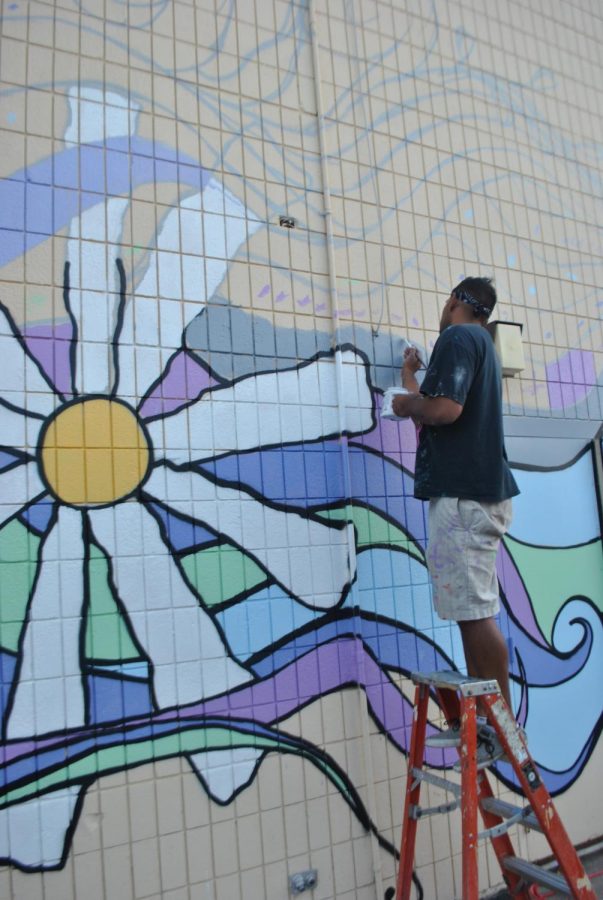UWO approves mural displaying diversity
Artist Irineo Medina’s previous mural in Appleton.
May 2, 2019
The first-ever piece of public art at UW Oshkosh will be displayed on the east side of Albee Hall following the Multicultural Mural Student Task Force gaining administrative approval for a mural.
The MMSTF has worked for over two years to get appropriate permission for the project to proceed to its final stage of being created.
Irineo Medina, a UWO alumni who works in printmaking, painting and photography, is the artist working alongside the MMSTF to create an image to represent the cultural and ethnic diversity on the UWO campus.
The purpose of the multicultural mural is to celebrate diversity, promote inclusivity and foster a sense of belonging for underrepresented students and groups at UWO as well as cultural appreciation and unity.
The idea for the mural is not new, but the circumstance that several members of the MMSTF found themselves in provided an opportunity for it to come to fruition.
“I guarantee you we weren’t the first ones to have that thought,” Nicholas Metoxen, a member of the MMSTF and co-president of the UWO Inter-tribal Student Organization said of the mural. “It just happened that enough of us had the thought at once and kind of jumped on it.”
This occurred at one of Chancellor Andrew Leavitt’s Late Night Breakfast events when students were prompted to think of ways that they could feel represented on campus.
“We couldn’t really come up with a whole lot of them,” Metoxen said. “The chancellor, he picked out a much different location and a much different plan, but he was talking about the potential of a mural on campus, and I think that just kind of sparked the interest in a whole bunch of different students who ended up getting together and saying, ‘How can we do this?”
The MMSTF had a lot of interest initially, but figuring out the process for approval and getting connected to the right people was a major challenge.
“We’ve never done projects like this before, so it was very difficult because we didn’t know who to go to,” said Pa Houa Xiong, chair of the MMSTF. “We had a lot of help from our advisers and from the organizations.”
This is how the group came into contact with JoAnn Rife, UWO’s director of planning and construction, who helped the MMSTF throughout the slow, bureaucratic process that followed.
The MMSTF then started looking for an artist and heard about Medina through Emmet Sandberg of the art department, who mentioned that Medina had painted murals in the stairways of Donner Hall in 2015.
“That was something that just really added a lot to the project being that it was a former student of color who graduated from this very University,” Metoxen said. “That meant something, you know, to have someone who really understands it, being a part of it.”
Medina was on board with the project right away, despite working a full-time job in Appleton and having a second child on the way.
“It’s always been a dream of mine since I started going here to paint on the outside somewhere,” Medina said. “It’s really exciting, you know, but it’s also a huge project, especially working through the red tape.”
The red tape didn’t hold Xiong, Metoxen or any of the students involved with the MMSTF back, and they recently received approval to proceed with the project.
“It came through, and it’s happening,” Medina said. “I’m super stoked. I think it’s an amazing opportunity for the University, for the people of color here on campus, for myself as an artist and an alumni, for us all to be able to work together.”
Working in bright, vibrant colors, Medina said his style is heavily influenced by the street art and graffiti subcultures.
“In public art I don’t want to be a negative message, you know. There’s enough of that in the world,” Medina said. “To be a positive voice and use art as a vehicle to uplift people, whether it be people of color, women or LGBTQ.”
The students in the MMSTF are thrilled to see their hard work start to materialize after putting in over two years of hard work — work that Medina says is harder than the painting itself.
“They killed it,” Medina said.














